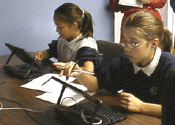
Pen computers can help children observe and record their information
Digital Technology
Using digital technology that is now available can help create presentations that are not only informative, but reusable. Computer technology should work in the background, creating an atmosphere that enhances education. Ubiquitous computing, or the use of the technology without the user being aware of it, is at our footsteps.
The art of teaching is very old and is based on the way humans communicate ideas to each other. We learn most from the interaction of humans; from parents, to preachers, to teachers.
Technology through the ages has helped teachers teach. The use of a sedimentary rock that is "chalky" on another rock that is flat and hard called slate, has been a very useful tool for communicating ideas. The invention of paper by the Chinese allowed communication to be transferred from one generation to another without interpretation.
|
|
However, limitations on one's culture can sometime impede more development. For instance, the ability to copy documents quickly allowed those nations to communicate to the masses. Logically the invention should have occurred in China where paper was developed, but the graphical language that it uses was not suitable for easy duplication. It took a language with a few characters, like the Germanic languages. Twenty-three characters allowed the invention of the printing press by Johan Gutenberg (1398-1468). The European countries now would take control, with the use of the printing press, provided nations with copies of a written language. A successful example of how communication and the ability to communicate to masses increases a region's visibility.
We are now at one of these pivotal times in the history of communication. Those nations that embrace and use technology to communicate and teach will once again become leaders. However, using new technology may require a look at how to incorporate the technology into mass communications.
We need to realize that people learn from past developments. Learning builds from prior knowledge that is transferred from one human to another. Our language develops from words, sentences, paragraphs, to stories. Math develops from basic numbers to higher order manipulation of those numbers. Science builds on previous discoveries and understandings of the world. History builds on events. People learn best when the sequence is logical and repetitive.
Learning is easiest when a person is young. The brain is like a sponge, wanting and retaining as much information as you give it. Fine motor skills like writing, stimulate learning. Imprinting in the neurons of the brains successfully helps humans to not only absorb but to retain the knowledge.
Humans tend to learn through many different styles of presentations. Repetition of skills like language and math are a very effective way of learning basic building blocks. The following are some basic ways that humans absorb information.
Humans learn in many different ways. Some people are more visual, while others are more sensory. Females tend to be more qualitative and males tend to be more quantitative. We are individuals, but teachers must teach to a group. The more ways of presenting a logical scope and sequence will add to the learning of all students. The human brain is mystical, but teachable.
There are many different examples of how digital technology can increase learning. The presentations that a teacher creates can be repeated over and over, enhances the child's learning. Digital technology allows educators a wealth of multimedia techniques at their fingertips. But the ability to create a logical "storyboard" is very important. The pictures, video clips, sound clips, and other multimedia presentation style only enhance the scope and sequence. Scope and Sequence whether in a lecture to adults or children is important. A lecture, presentation, or even a movie with a storyboard can leave people "knowing" versus people "wondering" why they came.
Electronic textbooks can become alive for students and teachers. Experiences that can correlate with hands-on science, and you have a positive learning tool.